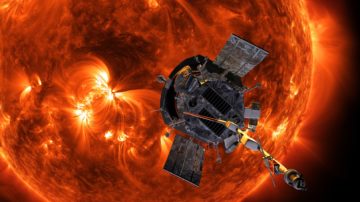Alexandra Witze in Nature:
 A NASA spacecraft has entered a previously unexplored region of the Solar System — the Sun’s outer atmosphere, or corona. The long-awaited milestone, which happened in April but was announced on 14 December, is a major accomplishment for the Parker Solar Probe, a craft that is flying closer to the Sun than any mission in history. “We have finally arrived,” said Nicola Fox, director of NASA’s heliophysics division, located at the agency’s headquarters in Washington DC. “Humanity has touched the Sun.”
A NASA spacecraft has entered a previously unexplored region of the Solar System — the Sun’s outer atmosphere, or corona. The long-awaited milestone, which happened in April but was announced on 14 December, is a major accomplishment for the Parker Solar Probe, a craft that is flying closer to the Sun than any mission in history. “We have finally arrived,” said Nicola Fox, director of NASA’s heliophysics division, located at the agency’s headquarters in Washington DC. “Humanity has touched the Sun.”
She and other team members spoke during a press conference at this week’s American Geophysical Union meeting in New Orleans, Louisiana. A paper describing the findings appears in Physical Review Letters1.
In many ways the Parker Solar Probe is a counterpoint to NASA’s twin Voyager spacecraft. In 2012, Voyager 1 travelled so far from the Sun that it became the first mission to leave behind the region of space dominated by the solar wind — the energetic flood of particles coming from the Sun. By contrast, the Parker probe is flying ever closer towards the heart of the Solar System, head-on into the solar wind and into our star’s atmosphere. With this new front-row seat scientists can explore some of the biggest unanswered questions about the Sun, such as how it generates the solar wind and how its corona gets heated to temperatures more extreme than those on the Sun’s surface.
“This is a huge milestone,” says Craig DeForest, a solar physicist at the Southwest Research Institute in Boulder, Colorado, who is not involved with the mission. Flying into the solar corona represents “one of the last great unknowns”, he says.
More here.
